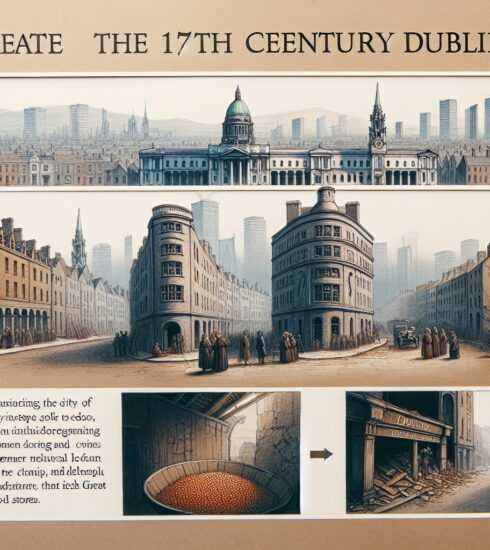Dublin Castle History: Delve into the Fascinating Legacy of Irish Power and Politics
Dublin Castle: Uncovering Centuries of Irish Power and Politics
Dublin Castle is a fascinating historical landmark that holds important significance in the history of Ireland. Nestled in the heart of Dublin city, this iconic structure has witnessed centuries of power struggles, political intrigue, and has served as a symbol of British rule in Ireland. Today, Dublin Castle stands as a testament to the enduring power and resilience of the Irish people.
A Brief Overview of Dublin Castle History
Dublin Castle has a long and storied history that dates back to the 13th century. It was originally built as a defensive fortification by the Anglo-Normans to assert their control over Ireland. Over the centuries, the castle underwent numerous transformations and expansions, becoming a symbol of British authority and the seat of government in Ireland.
During the Middle Ages, Dublin Castle served as the residence of the Lord Deputy, the English monarch’s representative in Ireland. It also housed the English administration and provided a base for the English military presence in Ireland. The castle played a central role in the consolidation of British power and the governance of Ireland.

In the 17th century, Dublin Castle underwent significant renovations under the direction of the Viceroy, Arthur Chichester. The castle was expanded and transformed into a grand palace in the Jacobean style, reflecting the architectural trends of the time. These renovations added a touch of elegance and grandeur to the castle, making it a beacon of power and authority.
Significance of Dublin Castle in Irish History
Dublin Castle holds great significance in the history of Ireland, representing a symbol of British rule and the struggles for Irish independence. Throughout the centuries, the castle was a focal point of political power, witnessing both oppression and resistance.
During the 18th and 19th centuries, Dublin Castle became the center of British colonial administration in Ireland. It was here that policies were devised and implemented that sought to control and suppress the aspirations of the Irish people. The castle was a potent symbol of British authority and a constant reminder of Ireland’s subordinate status within the British Empire.
However, Dublin Castle also played a role in Irish nationalist movements and the fight for independence. The castle saw pivotal moments in Irish history, such as the signing of the Anglo-Irish Treaty in 1921, which led to the creation of the Irish Free State. The Treaty negotiations took place in the historic State Drawing Room of Dublin Castle, marking a significant turning point in Irish history.
Exploring the Architecture of Dublin Castle
The architecture of Dublin Castle is a unique blend of medieval fortifications and grand palatial buildings. The castle’s exterior features a mix of medieval towers, ramparts, and sturdy walls, reflecting its original defensive purpose. Inside, visitors can marvel at the stunning interiors, with ornate ceilings, delicate plasterwork, and beautiful furnishings.
One of the most notable features of Dublin Castle is the State Apartments, which were built in the 18th century. These apartments served as the living quarters for the Viceroy and featured elegant reception rooms, private chambers, and a grand staircase. Today, the State Apartments are open to the public and offer a glimpse into the splendor of the castle’s past.
The Chapel Royal is another highlight of Dublin Castle’s architecture. Built in the 19th century, this beautiful chapel is adorned with exquisite stained glass windows, intricate woodwork, and a striking marble altar. The Chapel Royal is still used for special occasions and provides a serene and spiritual atmosphere within the castle grounds.
Exploring the Dublin Castle Grounds and Gardens
Dublin Castle is not just a historic building; it also boasts beautiful grounds and gardens that are worth exploring. The Dubhlinn Gardens, located at the heart of the castle, offer a peaceful retreat from the bustling city. Visitors can stroll through the gardens, admire the flower beds, and enjoy the tranquility of this hidden oasis.
Within the castle grounds, you’ll also find the Chester Beatty Library, a hidden gem that houses an incredible collection of manuscripts, rare books, and artworks from around the world. The library’s exhibitions provide a fascinating insight into the history of writing, printing, and bookbinding, making it a must-visit for book lovers and history enthusiasts alike.
Conclusion
Dublin Castle is more than just a historic landmark; it is a living testament to the power and resilience of the Irish people. It stands as a symbol of both British rule in Ireland and the struggles for Irish independence. Today, visitors can explore the castle’s fascinating history, immerse themselves in its stunning architecture, and discover the stories hidden within its walls. A visit to Dublin Castle is a journey through centuries of Irish power and politics, offering a deeper understanding of the complex and often turbulent history of Ireland.
Editor’s Note
Dublin Castle is an integral part of Irish history and a must-visit attraction for both locals and tourists. Its rich architectural heritage and historical significance make it an important landmark in understanding the complex relationship between Ireland and Britain. Whether you’re interested in history, art, or simply want to immerse yourself in the beauty of this iconic site, a visit to Dublin Castle is a truly enriching experience.








ᐈ Unearthing Dublin's Forgotten Landmarks: Haunted Tales of History and Mystery in the City's Heart. Dublin: Engaging, Insightful, Authentic.
11 months ago[…] Uncover the fascinating history of Dublin Castle here. […]